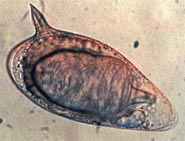Schistosomatidae
Schistosomatidae is a family of trematodes, commonly known as blood flukes. They are parasites that belong to the phylum Platyhelminthes, class Trematoda, and are unique among trematodes for their separate-sexed individuals, as most trematodes are hermaphroditic. Schistosomatidae are the causative agents of schistosomiasis, a disease that affects millions of people, primarily in tropical and subtropical regions of the world.
Characteristics[edit | edit source]
Members of the Schistosomatidae family are characterized by their elongated bodies, which are divided into two sexes, male and female, making them dioecious. The male is typically shorter and thicker than the female and possesses a gynecophoral canal, where the female resides during copulation. This unique adaptation allows for continuous fertilization of the eggs by the male. The surface of these parasites is covered with a tegument, which helps in protection against the host's immune system and in nutrient absorption.
Life Cycle[edit | edit source]
The life cycle of Schistosomatidae involves two hosts: a primary vertebrate host, where the parasite reaches maturity and reproduces sexually, and a secondary snail host, where asexual reproduction occurs. The cycle begins when eggs are excreted in the feces or urine of the infected vertebrate host. Once in water, the eggs hatch, releasing miracidia, which then infect specific snail species. In the snail, the parasites undergo several developmental stages, culminating in the production of cercariae. These free-swimming cercariae leave the snail and can infect a new vertebrate host by penetrating the skin, thus completing the cycle.
Disease[edit | edit source]
Schistosomatidae are responsible for schistosomiasis, also known as bilharzia or snail fever, which is a significant cause of morbidity in endemic areas. The disease manifests in various forms, depending on the species of Schistosoma and the affected organ systems, primarily the urinary tract or the intestines. Symptoms can range from mild, such as rash and itchy skin, to severe, including liver damage, kidney failure, infertility, and bladder cancer. Chronic infection can lead to significant morbidity and mortality.
Prevention and Control[edit | edit source]
Control and prevention of schistosomiasis involve a combination of strategies, including mass drug administration (MDA) to at-risk populations, improvement of sanitation, snail control, and health education. The drug praziquantel is widely used for treatment due to its effectiveness against all species of Schistosoma affecting humans.
Species[edit | edit source]
The genus Schistosoma includes several species that infect humans, including Schistosoma haematobium (causing urinary schistosomiasis), Schistosoma mansoni (causing intestinal schistosomiasis), and Schistosoma japonicum (also causing intestinal schistosomiasis). Other species within this family can infect birds and mammals but are not considered significant to human health.
Transform your life with W8MD's budget GLP1 injections from $125
W8MD offers a medical weight loss program NYC and a clinic to lose weight in Philadelphia. Our W8MD's physician supervised medical weight loss centers in NYC provides expert medical guidance, and offers telemedicine options for convenience.
Why choose W8MD?
- Comprehensive care with FDA-approved weight loss medications including:
- loss injections in NYC both generic and brand names:
- weight loss medications including Phentermine, Qsymia, Diethylpropion etc.
- Accept most insurances for visits or discounted self pay cost.
- Generic weight loss injections starting from just $125.00 for the starting dose
- In person weight loss NYC and telemedicine medical weight loss options in New York city available
- Budget GLP1 weight loss injections in NYC starting from $125.00 biweekly with insurance!
Book Your Appointment
Start your NYC weight loss journey today at our NYC medical weight loss, and Philadelphia medical weight loss Call (718)946-5500 for NY and 215 676 2334 for PA
Search WikiMD
Ad.Tired of being Overweight? Try W8MD's NYC physician weight loss.
Semaglutide (Ozempic / Wegovy and Tirzepatide (Mounjaro / Zepbound) available. Call 718 946 5500.
Advertise on WikiMD
|
WikiMD's Wellness Encyclopedia |
| Let Food Be Thy Medicine Medicine Thy Food - Hippocrates |
Translate this page: - East Asian
中文,
日本,
한국어,
South Asian
हिन्दी,
தமிழ்,
తెలుగు,
Urdu,
ಕನ್ನಡ,
Southeast Asian
Indonesian,
Vietnamese,
Thai,
မြန်မာဘာသာ,
বাংলা
European
español,
Deutsch,
français,
Greek,
português do Brasil,
polski,
română,
русский,
Nederlands,
norsk,
svenska,
suomi,
Italian
Middle Eastern & African
عربى,
Turkish,
Persian,
Hebrew,
Afrikaans,
isiZulu,
Kiswahili,
Other
Bulgarian,
Hungarian,
Czech,
Swedish,
മലയാളം,
मराठी,
ਪੰਜਾਬੀ,
ગુજરાતી,
Portuguese,
Ukrainian
Medical Disclaimer: WikiMD is not a substitute for professional medical advice. The information on WikiMD is provided as an information resource only, may be incorrect, outdated or misleading, and is not to be used or relied on for any diagnostic or treatment purposes. Please consult your health care provider before making any healthcare decisions or for guidance about a specific medical condition. WikiMD expressly disclaims responsibility, and shall have no liability, for any damages, loss, injury, or liability whatsoever suffered as a result of your reliance on the information contained in this site. By visiting this site you agree to the foregoing terms and conditions, which may from time to time be changed or supplemented by WikiMD. If you do not agree to the foregoing terms and conditions, you should not enter or use this site. See full disclaimer.
Credits:Most images are courtesy of Wikimedia commons, and templates, categories Wikipedia, licensed under CC BY SA or similar.
Contributors: Prab R. Tumpati, MD



